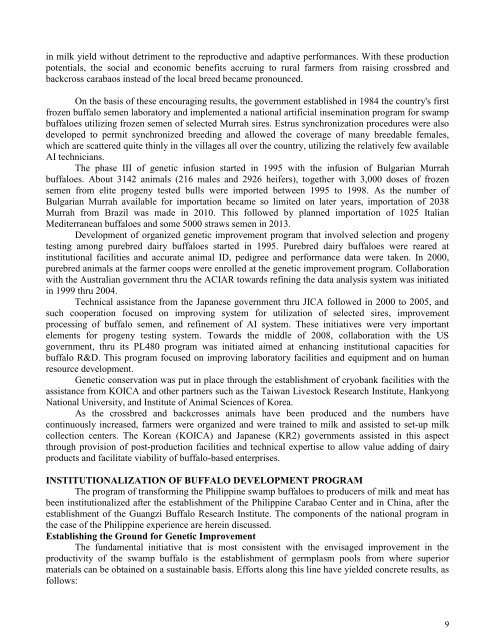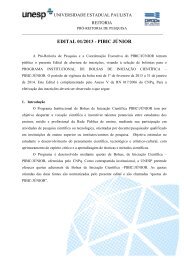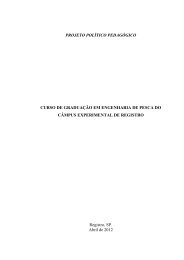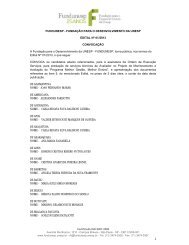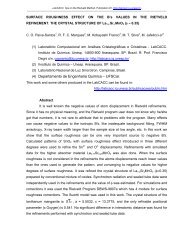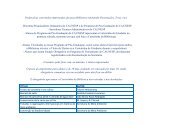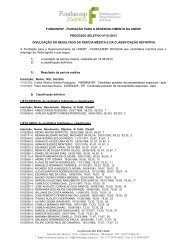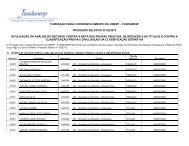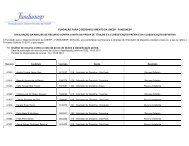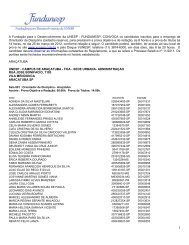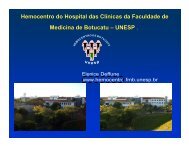Untitled - Faculdade de Medicina Veterinária e Zootecnia - Unesp
Untitled - Faculdade de Medicina Veterinária e Zootecnia - Unesp
Untitled - Faculdade de Medicina Veterinária e Zootecnia - Unesp
Create successful ePaper yourself
Turn your PDF publications into a flip-book with our unique Google optimized e-Paper software.
in milk yield without <strong>de</strong>triment to the reproductive and adaptive performances. With these production<br />
potentials, the social and economic benefits accruing to rural farmers from raising crossbred and<br />
backcross carabaos instead of the local breed became pronounced.<br />
On the basis of these encouraging results, the government established in 1984 the country's first<br />
frozen buffalo semen laboratory and implemented a national artificial insemination program for swamp<br />
buffaloes utilizing frozen semen of selected Murrah sires. Estrus synchronization procedures were also<br />
<strong>de</strong>veloped to permit synchronized breeding and allowed the coverage of many breedable females,<br />
which are scattered quite thinly in the villages all over the country, utilizing the relatively few available<br />
AI technicians.<br />
The phase III of genetic infusion started in 1995 with the infusion of Bulgarian Murrah<br />
buffaloes. About 3142 animals (216 males and 2926 heifers), together with 3,000 doses of frozen<br />
semen from elite progeny tested bulls were imported between 1995 to 1998. As the number of<br />
Bulgarian Murrah available for importation became so limited on later years, importation of 2038<br />
Murrah from Brazil was ma<strong>de</strong> in 2010. This followed by planned importation of 1025 Italian<br />
Mediterranean buffaloes and some 5000 straws semen in 2013.<br />
Development of organized genetic improvement program that involved selection and progeny<br />
testing among purebred dairy buffaloes started in 1995. Purebred dairy buffaloes were reared at<br />
institutional facilities and accurate animal ID, pedigree and performance data were taken. In 2000,<br />
purebred animals at the farmer coops were enrolled at the genetic improvement program. Collaboration<br />
with the Australian government thru the ACIAR towards refining the data analysis system was initiated<br />
in 1999 thru 2004.<br />
Technical assistance from the Japanese government thru JICA followed in 2000 to 2005, and<br />
such cooperation focused on improving system for utilization of selected sires, improvement<br />
processing of buffalo semen, and refinement of AI system. These initiatives were very important<br />
elements for progeny testing system. Towards the middle of 2008, collaboration with the US<br />
government, thru its PL480 program was initiated aimed at enhancing institutional capacities for<br />
buffalo R&D. This program focused on improving laboratory facilities and equipment and on human<br />
resource <strong>de</strong>velopment.<br />
Genetic conservation was put in place through the establishment of cryobank facilities with the<br />
assistance from KOICA and other partners such as the Taiwan Livestock Research Institute, Hankyong<br />
National University, and Institute of Animal Sciences of Korea.<br />
As the crossbred and backcrosses animals have been produced and the numbers have<br />
continuously increased, farmers were organized and were trained to milk and assisted to set-up milk<br />
collection centers. The Korean (KOICA) and Japanese (KR2) governments assisted in this aspect<br />
through provision of post-production facilities and technical expertise to allow value adding of dairy<br />
products and facilitate viability of buffalo-based enterprises.<br />
INSTITUTIONALIZATION OF BUFFALO DEVELOPMENT PROGRAM<br />
The program of transforming the Philippine swamp buffaloes to producers of milk and meat has<br />
been institutionalized after the establishment of the Philippine Carabao Center and in China, after the<br />
establishment of the Guangzi Buffalo Research Institute. The components of the national program in<br />
the case of the Philippine experience are herein discussed.<br />
Establishing the Ground for Genetic Improvement<br />
The fundamental initiative that is most consistent with the envisaged improvement in the<br />
productivity of the swamp buffalo is the establishment of germplasm pools from where superior<br />
materials can be obtained on a sustainable basis. Efforts along this line have yiel<strong>de</strong>d concrete results, as<br />
follows:<br />
9


